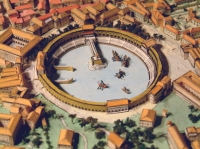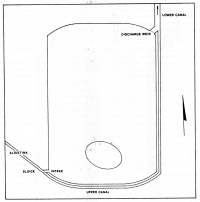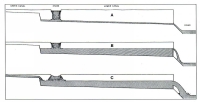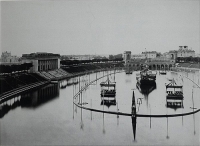
 |
 |

Above reconstructions with intake and outlet (top) and the naumachia's weir system with three weir settings (from: "Public Needs and Private Pleasures", R. Taylor 2000)
Famous was the naumachia held in that year in the presence of Napoleon, similar to the one above. The photo should be of 1807 (source: vecchiomilano.worldpress.com).
Naumachia
A popular form of entertainment was the naumachia (sham naval battle on articial lakes). These not-so-sham battles were the most elaborate of all spectacles offered at Roman celebrations. The contestants butchered one another until one side or the other was eliminated; the victors, if they fought bravely, were occasionally given their freedom. The Emperor Domitian had the arena of the Coliseum flooded and reproduced an historic naval battle. Special piping was installed under the floor for flooding. The arena, however, proved to be too small. Roman historians report that Domitian staged sham naval battles with almost regular fleets, having dug an artificial lake near the Tiber River and surrounded it with seats. His enthusiasm was so great he continued to watch contests amid heavy rains (Suetonius, trans. by Rolfe, 1951). Generally the aqueduct with poorest quality water was used to fill the naumachia.According to Suetonius (Dom. 5), Trajan used stone from a naumachia to repair the Circus Maximus after a fire. There is some evidence that Trajan built his own naumachia. This would probably have had a non-trivial impact on the management of the water supply. Either they needed a supply of water to constantly refresh them in order to avoid turning them into mosquito breeding grounds, or they were only filled when needed and then emptied. Either way, a considerable anount of water would have been required for them.
From the thesis of Evan J. Dembskey on The aqueducts of Ancient Rome